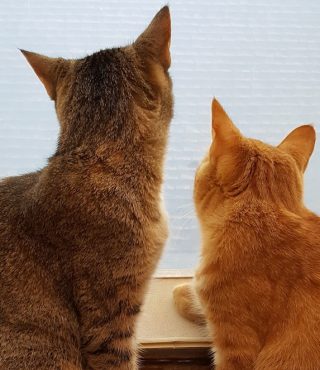Cats and Birds and Cold Weather

Cold weather has arrived – or most days, anyway – and with it come a number of dangers for cats and birds. Many bird species are sensible enough to migrate, and those that do not have adaptations to help them survive the Canadian winters. Feathers provide warmth and insulation, and many species grow extra feathers in the fall. Some birds also have an oily coating on their feathers, which adds some weatherproofing, and birds can fluff themselves up, creating air pockets that provide additional insulation. They often increase their fat intake too, and the reserves help provide extra energy so they can generate more body heat. One of the more charming winter adaptions is the habit of some birds of standing on one leg, tucking the other up next to their body to minimize heat loss.
Cold weather is also challenging for cats. Most cats prefer to stay inside in the winter, avoiding the pesky snow sticking to their paws. Despite their fur coats, most cats are as vulnerable to frostbite and hypothermia. (There are breeds of cats, such as the Norwegian Forest Cat or Maine Coon, that are more adapted to cold weather, but most cats are just as vulnerable to frostbite and hypothermia as humans are.) Sadly, many owners still let their cats out in winter, and rescues are routinely called on to help cats that are found frozen to the ground. Frostbite is most likely to occur on a cat’s paw pads and ears, but can occur anywhere on the cat’s body when that area is exposed to cold temperatures long enough.
How cold is too cold for cats? Freezing, basically. Generally, when the temperature hits zero (32F), the risk to cats of hypothermia and frostbite are high.
Another cold weather risk to cats is antifreeze, a nasty poison. For some mysterious reason, it tastes good to cats, and as little as a teaspoon can be fatal. Ice melters can also be dangerous as the chemicals used can be toxic.
Cars are also an issue, of course, both in the usual risk of getting hit by one, and in the special winter danger of warm engines. Cats will often sleep on cars to borrow some of that engine warmth, and sometimes climb up into the engine compartment or wheel wells to shelter from the wind. If you do let your cat into the garage – not a practice we recommend! – give the hood a few good whacks on your way by.
As in all seasons, the best way to avoid all these dangers is to keep your cat from roaming! If you need help adapting your cat to contentment indoors, click here for some Tips for Transitioning.








